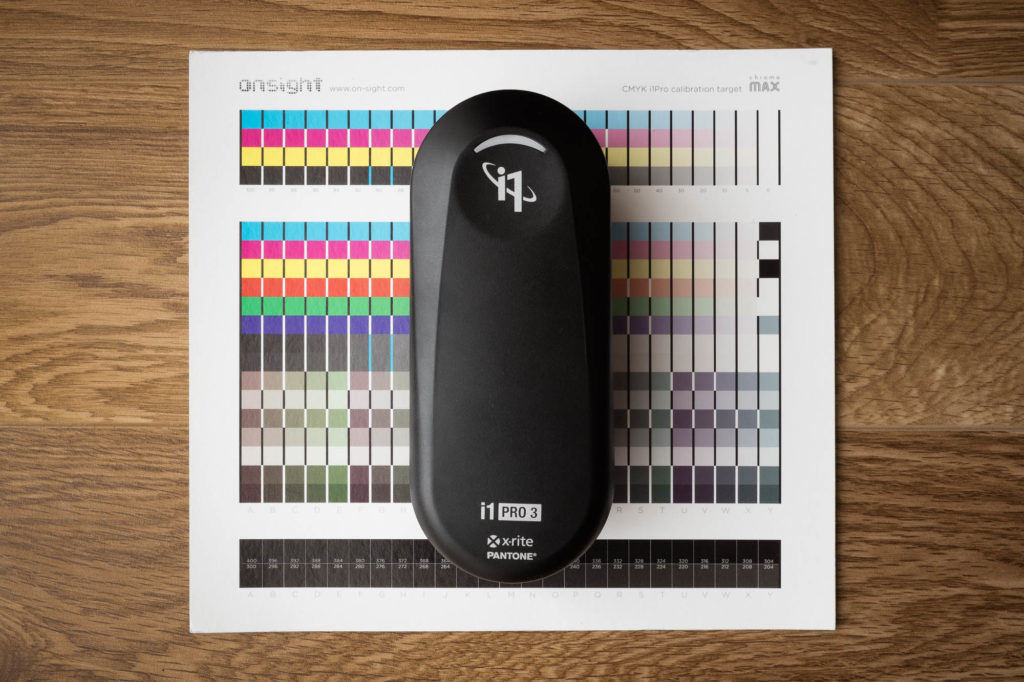
XRIte announced the i1Pro3 spectrophotometer and released i1Profiler 3.2 which supports it. This is the standard aperture i1Pro, not to be confused with the large aperture i1Pro3plus. The i1Pro2 was the Swiss Army Knife of spectrophotometers and the best selling of all time. The i1Pro3 is a worthy successor with a variety of refinements, most notably:
- Combined MO, M1 and M2 measurements in a single pass, thanks to a new full-spectrum LED light source.
- Significantly improved strip reading
- Support for smaller patches than the i1Pro2
- Support for existing i1Pro targets
- Support for displays with higher brightness levels
The i1Pro3 does not have the same compatibility mode that the i1Pro2 had, so software must be updated to support it. Aside from this, I have found switching from the i1Pro2 to the i1Pro3 to be seamless. The smaller patch sizes are convenient and existing targets made for the i1Pro2 (like P2P targets) can be measured without reformatting. I can’t understate how improved and more forgiving strip reading is thanks to the i1Pro’s 400 measurements per second, which is double that of the i1Pro2. Faster reading with fewer errors, and combined M0,M1 and M2 measurements in one pass does lead to less frustration and increased productivity.
XRite claims improved measurement repeatability and inter-instrument agreement. My own testing suggests that measurement repeatability is improved with deviations half that of the i1Pro2. XRite tells me that the illumination optics in the i1Pro3 are improved to be more consistent to that of reference grade devices. This caused me to ask “How well do measurements correlate between i1Pro2 and i1Pro3 devices?” What I’ve found is that while extremely saturated blues and yellows can exhibit deviations around 1.2 dE00, the vast majority of colors correlate below 1.0 dE00 when measured with both devices on common matte and satin paper surfaces. Overall I’ve found switching from the i1Pro2 to the i1Pro3 to be extremely straightforward and without surprises. The i1Pro3 is clearly a better device in every way and I’m confident others will have a seamless transition when the time comes for them to upgrade.
Looking at this 3rd generation of Xrite devices there are a few things to note. Both the i1Pro3 and i1Pro3plus are designed and assembled in Switzerland. The internal arm mechanism of the new i1iO3 table has been re-engineered with more precise and longer laster metal parts. The i1iO3 table supports 3rd generation i1Pros, not older devices. The i1Pro3plus differentiates itself form the standard aperture i1Pro3 not only from its large aperture, but also its ability to create polarized M3 and transmissive profiles. The i1Pro3 and i1Pro3plus have a nice textured exterior that won’t degrade over time like the rubberized coating we’ve seen in the past. The i1Pro2, i1Pro3 and i1Pro3plus all use unique ‘zebra stripe’ rulers that are not interchangeable with each other. The i1Pro3 and i1Pro3plus also come with device specific filters, spot measurement and display calibration adapters. If you own all of these devices some labeling of these accessories can be helpful, especially if you travel with them.
Speaking of traveling, I’ve traveled with spectrophotometers for over 20 years now. While this experience used to be scary with the devices fragile tungsten light sources, I think it’s time to say that today’s solid state, LED light source spectros are completely road worthy. I am relieved to say that my iSis2XL and an i1Pro2 have been to nearly every continent through hundreds of flights and still correlate precisely to new units that haven’t traveled.
For the past few months I’ve been traveling with the iSis2XL, i1Pro2 , i1Pro3 and i1Pro3plus all in the same travel case. It’s nice to have a full set of tools that lets me get the very best quality out of any situation: any display, projector, scanner, or printer, with any RIP and substrate.
